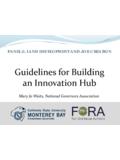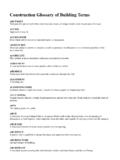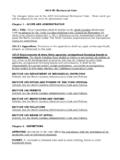Transcription of Future of automotive retail - ey.com
1 Future of automotive retail Shifting from transactional to customer-centric Future of automotive retail 2. Contents automotive retail in the Future 03. A paradigm shift in auto retail based on five key pillars 04. Managing trust and complexity throughout customer life cycle 05. Customizing value propositions 06. Creating an engaging digital experience 07. Redesigning distribution networks 08. Crafting an omni-channel brand management strategy 09. Key considerations for stakeholders 10. How EY can help you? 11. automotive retail in the Future Evolving from bricks-and-mortar to an omni-channel strategy Achieving this transformation in automotive retail will not only require a concerted effort from both automakers and dealers, but will also automotive retail will shift from a demand an unprecedented level of collaboration product-driven to a customer-centric with other stakeholders in the ecosystem, approach to drive customer loyalty and to particularly insurance companies, auto finance and aftersales market participants.
2 Adapt to changing customer behavior and For automakers, they have an opportunity, for expectations. the first time, to not only build a relationship with the customer by leveraging connected vehicles, but also to deliver a rich brand The rise of new mobility concepts and experience through seamless integration across all customer-facing channels. shifting mobility preferences of private For dealers, the transformation is a significant and commercial customers ( , private- opportunity to streamline their operations and business-car sharing, electric by shedding non-value-adding functions vehicles and an increasing role of used and unlocking capital from redundant infrastructure, while taking on a wider service cars and fleet) are causing automakers portfolio that contributes to better margins. and automotive retailers to rethink their In the short term, there is a clear need for current business model.
3 Stakeholders across the automotive retail ecosystem to undertake significant change management to catch up with the broader retail industry. Customers are able to quickly This is an executive summary of our analysis of interact and easily access the Future of automotive retail , where we discuss information across media and the key forces at play and steps that stakeholders in this ecosystem should take to meet the devices anytime, anywhere. This needs of customers, and remain relevant and needs to reflect in the customer competitive.. experience and marketing strategies. Randall J. Miller Global automotive and Transportation Sector Leader, EY. Future of automotive retail 3. Future of automotive retail 4. Paradigm shift in auto retail Digitization, regulations, evolving customer needs and new competitors necessitate a rethink of the retail model Significant changes in the operating environment and within the auto retail ecosystem are forcing automakers and dealerships to rethink their model.
4 We believe this will drive a major paradigm shift in auto retailing over the next decade, based on five key pillars. retail sector changes Increasing competition in Five pillars of the paradigm shift Retailers moving from auto retail and aftersales multi-channel to omni-channel Online and boutique stores Independent fast fitters 1. Original equipment supplier Increasing use of big data (OES) workshops Managing trust rating environm and complexity Ope and analytics en Changing customer throughout t behavior Crafting 5 customer Digital becoming the starting an omni- life cycle Product evolution rs point for a purchase journey channel brand ake management NSC. Increasing vehicle complexity New mobility preferences Autom strategy Faster replacement rates Rapid technology evolution Creating an engaging s*/dealers Need for customization Higher demand for used cars 2.
5 Customer and fleet service Customizing journey value propositions Increasing stakeholder 4. influence Customers Redesigning Regulations distribution Auto-leasing and insurance networks companies CO2 emissions standards Vehicle comparison sites Repair legislation Creating an engaging Online comparison sites and configurators Direct sales legislation Safety standards digital 3. experience Financial institutions *National Sales Company 1 Managing trust and complexity throughout the customer life cycle to maintain customer loyalty We believe automakers and dealers must focus on transforming the overall customer experience Managing customer experience across Market indicators and ultimately develop into a trusted organization. An integrated customer experience strategy is key to building loyalty, retention, and consequently higher profit margins in sales and aftersales.
6 Multiple touch points is critical to build a In order to transform a customer from a buyer to a brand advocate, trusted relationships need to trusted relationship be built by injecting trust-building attributes into every customer interaction. First contact 72% Building blocks for the new auto retail agenda 1. Knowledgeable customers: with the mobile, digital and social media proliferation, customers can now Consumers feel that access diverse information ranging from vehicle performance, to cost of ownership and financing, an improved buying to ownership and aftersales experiences. This will drive the need for a personalized and relevant process would motivate customer experience throughout the customer journey. them to visit dealerships New customer relationship management (CRM) considerations: huge data generated from multiple more often customer touch points will result in various CRM considerations.
7 These include better customer insights, better segmentation, and proactive sales and service initiation. Consequently, it will also 2 Vehicle research and test drive 6. be critical to be transparent with customers on how their data is being handled and used, with clear opt-out options. Customer life cycle management: to increase customer retention, customer experience will be Replacement managed consistently across the customer life cycle, from vehicle research to aftersales moving to 70% replacement. 0rganizations believe that What can automakers, NSCs and dealers do? 3. an increasing emphasis Vehicle Design customer experience: design and implement a customer experience that is consistent with on customer experience is driving business growth the brand identity and establishes trust across touch points Warranty and repair 5 financing Transform processes and systems: transform processes and systems that impact sales, service, strategies marketing and CRM to enable a seamless customer experience Manage change and realign incentive structures to focus on trust: drive change management to enable employees to deliver the envisioned customer experience 4.
8 Source: Car Buyer of the Future , Vehicle AutoTrader, 2015; The perfect Focus on key trust drivers: launch specific programs to build authenticity, transparency and delivery landing: an engaging customer consistency experience, EY, 2014. Future of automotive retail 5. Future of automotive retail 6. 2 Rethinking value propositions to meet changing mobility preferences of customers and growing aftersales competition For automakers and dealers to continue to be relevant, it will be critical to create value propositions Market indicators that help customers tailor their mobility packages. This could involve offering choices ranging from buying vehicles to designing a package involving access to multiple vehicles and modes of transport. Thus, the focus shifts from the experience of driving the vehicle, to experiencing the Customers brand. In addition, with regulations pushing for greater competition from independent repair specifying mobility market, an integrated aftersales value proposition may be the only way to create repeat customers.
9 Preferences Building blocks for the new auto retail agenda 24% 44% A market for mobility services: the shifting preference from vehicle ownership to access will require Consumers in Germany, the industry to create new value propositions offering mobility services and follow a service-centric the UK and Russia approach to automotive retail . consider car sharing a Making alternate powertrain vehicles as attractive as conventional fuel vehicles: the evolving viable option to vehicle regulatory landscape and increased customer awareness of clean energy vehicles have generated ownership interest, but translation into volumes will require the retail network to be well-equipped in terms of skills and key tools. In particular, sales and aftersales teams will need to be trained on the right competencies, including the ability to package mobility services, and also create smart tools to give customers transparency on ownership economics.
10 Optimized mobility 25% Increasing competition in the aftersales market: regulatory requirements related to aftersales will result in several new entrants in aftersales giving vehicle owners multiple options for vehicle service packages and repair. Survey respondents What can automakers, NSCs and dealers do? consider car ownership not important and are Reconfigure services, portfolio and processes: introduce and establish tools to create customized willing to shift to access mobility solutions and integrated service packages and use alternative Identify new business models: automakers and dealers will need to collaborate with key aftersales Access to mobility services participants to create complementary service offerings that will differentiate, attract and retain multiple vehicles customers Manage skill-gap of sales and services personnel: launch specialized training for sales and service personnel and monitor performance Source: Multi-channel distribution.














